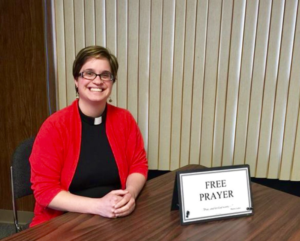Today’s post is from Shelly Satran, a pastor at Our Savior Lutheran Church in Vero Beach, FL.
How can we engage children in worship when we don’t know if there will even be any?
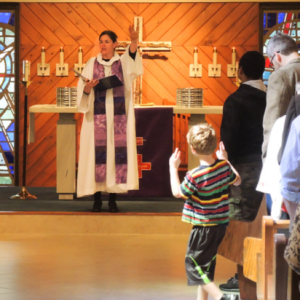 We regularly ask ourselves this question at the congregation I serve. We have families and children in our congregation, but spread across our three worship services, and given our demographic in a Florida coastal retirement town we never know if we might have two kids (“kids” used broadly here, one might be a toddler and one a teenager) or ten at a worship service.
We regularly ask ourselves this question at the congregation I serve. We have families and children in our congregation, but spread across our three worship services, and given our demographic in a Florida coastal retirement town we never know if we might have two kids (“kids” used broadly here, one might be a toddler and one a teenager) or ten at a worship service.
This question presented itself to us eight years ago when we realized children’s sermons weren’t working in our context. We decided to drop them, but committed to involving kids in worship in any way we could. We still have work to do, but here are some things that have been successful.
The first simple way we engage kids in worship, is to ask them! This one is a no-brainer, but still worth stating. We wear ourselves out texting, calling, asking in person, instant messaging, anything we can think of to involve young people in worship. As a result, not counting the youth acolytes, there is rarely a Sunday service that we don’t have youth or children involved as ushers, greeters, readers, musicians (from 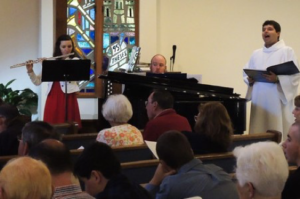 talented high school instrumentalists to an eight-year-old playing the rain stick), or worship leaders. It is definitely harder work to get youth to commit versus an adult. We have more issues with no shows than we do with adults, but it is worth it. The more we ask our young people to participate in the regular roles in worship the more they feel worship is for them.
talented high school instrumentalists to an eight-year-old playing the rain stick), or worship leaders. It is definitely harder work to get youth to commit versus an adult. We have more issues with no shows than we do with adults, but it is worth it. The more we ask our young people to participate in the regular roles in worship the more they feel worship is for them.
Secondly, and this falls into an important category for us of ideas we can add or omit depending on whether children are present, is to have a “kids’ question” in the sermon. This works similarly to how a children’s sermon question might work, but the kids are less on the spot, they can choose to raise their hand from their seats or not, and they are never on their own to answer because there are always adults who may whisper the answer or can’t help but blurt it out themselves. Plus we fold the questions into the sermon so that it isn’t a separate kids’ moment, but rather they are a part of what everyone else is participating in—God’s Word.
Our kids’ questions might involve an activity like: “Look through your worship folder/bulletin and count how many times the word “peace” appears.” As they are looking the sermon continues, but at some point I ask the kids for the answer and fold it into the rest of the sermon. Another kid’s question might be to circle all of the animals (or plants, or towns, or disciples, or anything that forms a small category) in the readings and show me after worship. Sometimes, not always, I have stickers or candy in my pocket as a prize.
The kids’ question might be some very basic Bible trivia that even the youngest would know or it might relate to the bulletin cover art—“Listen to the Gospel reading and see if you can name the three people depicted on the bulletin.” The great thing about the kids’ question is that it works if there are 20 kids in worship or two or zero. We have a Saturday night worship service that is usually not attended by kids, except for one not-shy boy. I will often call the kids question the “Gregory question” at that service, or if no kids are present I will make the kids’ question into an everybody question. We don’t have the kids’ question in the sermon every week. Then it would lose some of its novelty, but regularly enough that the kids know to listen up and wait for it.
Third, and also in the category of easily added or omitted, during the sending hymn we gather up any youth in worship (again they may range from toddler to teenager) invite them up front with the pastors and worship leaders. By “gather them up” I mean one of us pastors walks out and gets them. Or at a service with more children, we send older kids out to do the gathering. Once the young people are all up front, two or twelve of them, we all recess out of worship together and then the children lead the final “Go in Peace. Serve the Lord.” sending from the baptismal font. We’ve never had any trouble recruiting kids for this role probably because being first to the back of the sanctuary positions them to be first in line for cookies after worship.
 So if you are like us and you may only have a smattering of children in worship, don’t be discouraged. Wear yourself out to include them. It will be worth the effort. To them and the congregation, their presence will feel larger than the actual numbers. Hear it in the voices of children: “Go in Peace. Serve the Lord!”
So if you are like us and you may only have a smattering of children in worship, don’t be discouraged. Wear yourself out to include them. It will be worth the effort. To them and the congregation, their presence will feel larger than the actual numbers. Hear it in the voices of children: “Go in Peace. Serve the Lord!”
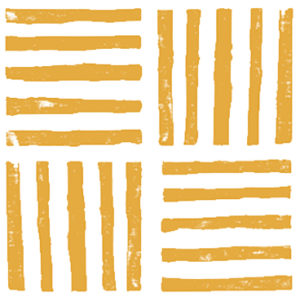 For over ten years Music That Makes Community has hosted workshops around the United States and Canada inviting participants to experience the power of paperless singing. The work started with a question and a challenge: how could we invite worshippers to participate in liturgy without hymnals, bulletins, or screens? How might clergy and musicians develop the skills – non-verbal communication, modeling and imitation, focused listening – to lead song (and liturgy) with sensitivity and care? And without minimizing the richness and depth of musical experiences mediated through paper, how could singing ‘by heart’ strengthen community and invite the participation of reluctant or disenfranchised singers?
For over ten years Music That Makes Community has hosted workshops around the United States and Canada inviting participants to experience the power of paperless singing. The work started with a question and a challenge: how could we invite worshippers to participate in liturgy without hymnals, bulletins, or screens? How might clergy and musicians develop the skills – non-verbal communication, modeling and imitation, focused listening – to lead song (and liturgy) with sensitivity and care? And without minimizing the richness and depth of musical experiences mediated through paper, how could singing ‘by heart’ strengthen community and invite the participation of reluctant or disenfranchised singers?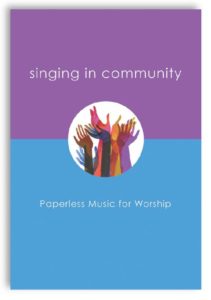 group of living composers, MMC has been developing a body of song for use in liturgy and community life. Singing in Community published by Augsburg Fortress in July 2017 is our newest compilation, with 50+ songs drawn from our first collection, Music By Heart, global songs, and new material written by our workshop facilitators and participants.
group of living composers, MMC has been developing a body of song for use in liturgy and community life. Singing in Community published by Augsburg Fortress in July 2017 is our newest compilation, with 50+ songs drawn from our first collection, Music By Heart, global songs, and new material written by our workshop facilitators and participants.

 We regularly ask ourselves this question at the congregation I serve. We have families and children in our congregation, but spread across our three worship services, and given our demographic in a Florida coastal retirement town we never know if we might have two kids (“kids” used broadly here, one might be a toddler and one a teenager) or ten at a worship service.
We regularly ask ourselves this question at the congregation I serve. We have families and children in our congregation, but spread across our three worship services, and given our demographic in a Florida coastal retirement town we never know if we might have two kids (“kids” used broadly here, one might be a toddler and one a teenager) or ten at a worship service. talented high school instrumentalists to an eight-year-old playing the rain stick), or worship leaders. It is definitely harder work to get youth to commit versus an adult. We have more issues with no shows than we do with adults, but it is worth it. The more we ask our young people to participate in the regular roles in worship the more they feel worship is for them.
talented high school instrumentalists to an eight-year-old playing the rain stick), or worship leaders. It is definitely harder work to get youth to commit versus an adult. We have more issues with no shows than we do with adults, but it is worth it. The more we ask our young people to participate in the regular roles in worship the more they feel worship is for them. So if you are like us and you may only have a smattering of children in worship, don’t be discouraged. Wear yourself out to include them. It will be worth the effort. To them and the congregation, their presence will feel larger than the actual numbers. Hear it in the voices of children: “Go in Peace. Serve the Lord!”
So if you are like us and you may only have a smattering of children in worship, don’t be discouraged. Wear yourself out to include them. It will be worth the effort. To them and the congregation, their presence will feel larger than the actual numbers. Hear it in the voices of children: “Go in Peace. Serve the Lord!”